Pathophysiology > TEST BANK > Pathophysiology: The Biologic Basis for Disease in Adults and Children 8th Edition By McCance, Hueth (All)
Pathophysiology: The Biologic Basis for Disease in Adults and Children 8th Edition By McCance, Huether Test Bank
Document Content and Description Below
Pathophysiology: The Biologic Basis for Disease in Adults and Children 8th Edition By Kathryn L. McCance, Sue E. Huether Test Bank NURSINGTB.COM Chapter 1: Cellular Biology MULTIPLE CHOICE 1. Which st... atement best describes the cellular function of metabolic absorption? a. Cells can produce proteins. c. Cells can take in and use nutrients. b. Cells can secrete digestive enzymes. d. Cells can synthesize fats. ANS: C In metabolic absorption, all cells take in and use nutrients and other substances from their surroundings. The remaining options are not inclusive in their descriptions of cellular metabolic absorption. PTS: 1 REF: Page 2 2. Most of a cell’s genetic information, including RNA and DNA, is contained in the: a. Mitochondria c. Nucleolus b. Ribosome d. Lysosome ANS: C The nucleus contains the nucleolus, a small dense structure composed largely of RNA, most of the cellular DNA, and the DNA-binding proteins, such as the histones, which regulate its activity. The other options do not contain most of a cell’s genetic information. PTS: 1 REF: Page 2 3. Which component of the cell produces hydrogen peroxide (H2O2) by using oxygen to remove hydrogen atoms from specific substrates in an oxidative reaction? a. Lysosomes c. Ribosomes b. Peroxisomes d. Oxyhydrosomes ANS: B Peroxisomes are so named because they usually contain enzymes that use oxygen to remove hydrogen atoms from specific substrates in an oxidative reaction that produces H2O2, which is a powerful oxidant and potentially destructive if it accumulates or escapes from peroxisomes. Ribosomes are RNA-protein complexes (nucleoproteins) that are synthesized in the nucleolus and secreted into the cytoplasm through pores in the nuclear envelope called nuclear pore complexes. Lysosomes are saclike structures that originate from the Golgi complex and contain more than 40 digestive enzymes called hydrolases, which catalyze bonds in proteins, lipids, nucleic acids, and carbohydrates. Oxyhydrosomes are involved in enzyme production. PTS: 1 REF: Page 8 4. Which cell component is capable of cellular autodigestion when it is released during cell injury? a. Ribosome c. Smooth endoplasmic reticulum b. Golgi complex d. Lysosomes ANS: D The lysosomal membrane acts as a protective shield between the powerful digestive enzymes within the lysosome and the cytoplasm, preventing their leakage into the cytoplasmic matrix. Disruption of the membrane by various treatments or cellular injury leads to a release of the lysosomal enzymes, which can then react with their specific substrates, causing cellular self-digestion. The other options do not correctly describe this process. PTS: 1 REF: Pages 7-8 5. What is the sequence of steps in the development of a digestive enzyme by the pancreas cells from the initial transcription to the release from the cell? a. The enzyme is transcribed from DNA by RNA in the nucleus, proceeds to the ribosome for synthesis, and is transported in a secretory vesicle to the cell membrane. b. The enzyme is transcribed from RNA by DNA in the nucleus, proceeds to the lysosome for synthesis, and is transported in an encapsulated membrane to the cell membrane. c. The enzyme is transcribed by the mitochondria in the nucleus, proceeds to the ribosome for synthesis, and is transported in a cytoskeleton to the cell membrane. d. The enzyme is transcribed from DNA by RNA in the nucleus, proceeds to the Golgi complex for synthesis, and is transported in a cytosol to the cell membrane. ANS: A The enzyme is transcribed from DNA by RNA in the nucleus, proceeds to the ribosome for synthesis, and is transported in a secretory vesicle to the cell membrane. The other options do not correctly describe this process. PTS: 1 REF: Page 7 | Figure 1-5 6. During which phase of the cell cycle is DNA synthesized? a. G1 c. G2 b. S d. M ANS: B The four designated phases of the cell cycle are: (1) the G1 phase (G = gap), which is the period between the M phase (M = mitosis) and the start of DNA synthesis; (2) the S phase (S = synthesis), during which DNA is synthesized in the cell nucleus; (3) the G2 phase, during which RNA and protein synthesis occurs, the period between the completion of DNA synthesis and the next phase (M); and (4) the M phase, which includes nuclear and cytoplasmic division. PTS: 1 REF: Page 37 7. What organic compound facilitates transportation across cell membranes by acting as receptors, transport channels for electrolytes, and enzymes to drive active pumps? a. Lipids c. Proteins b. Proteases d. Carbohydrates ANS: C PATHOPHYSIOLOGY 8TH EDITION MCCANCE TEST BANK Proteins act as (1) recognition and binding units (receptors) for substances moving in and out of the cell; (2) pores or transport channels for various electrically charged particles called ions or electrolytes and specific carriers for amino acids and monosaccharides; and (3) specific enzymes that drive active pumps that promote the concentration of certain ions, particularly potassium (K+), within the cell while keeping concentrations of other ions, for example, sodium (Na+), below the concentrations found in the extracellular environment. The other options do not correctly describe this process. PTS: 1 REF: Page 13 | Page 15 8. Understanding the various steps of proteolytic cascades, such as caspase-mediated apoptosis and complement cascades, may be useful in designing drug therapy for which human diseases? a. Cardiac and vascular disorders b. Autoimmune and malignant disorders c. Gastrointestinal and renal disorders d. Endocrine and gastrointestinal disorders ANS: B Understanding the various steps involved in this process is crucial for designing drug interventions. Dysregulation of proteases features prominently in many human diseases, including cancer, autoimmunity, and neurodegenerative disorders. The other options do not correctly describe this process. PTS: 1 REF: Page 15 9. Which structure prevents water-soluble molecules from entering cells across the plasma membrane? a. Carbohydrate chains c. Membrane channel proteins b. Glycoprotein channels d. Lipid bilayer ANS: D The bilayer’s structure accounts for one of the essential functions of the plasma membrane. It is impermeable to most water-soluble molecules (molecules that dissolve in water) because the water-soluble molecules are insoluble in the oily core region. The bilayer serves as a barrier to the diffusion of water and hydrophilic substances while allowing lipid-soluble molecules, such as oxygen (O2) and carbon dioxide (CO2), to diffuse through it readily. The other options do not correctly describe this process. PTS: 1 REF: Pages 12-13 10. The fluid mosaic model explains: a. How a cell membrane functions b. Why our bodies appear to be solid c. How tissue is differentiated d. How fluid moves between the intracellular and extracellular compartments ANS: A The fluid mosaic model accounts for the flexibility of cellular membranes, their self-sealing properties, and their impermeability to many substances. The remaining options do not explain the mosaic model. PTS: 1 REF: Page 12 | What's New box 11. Which form of cell communication is used to communicate within the cell itself and with other cells in direct physical contact? a. Protein channel (gap junction) b. Plasma membrane–bound signaling molecules (involving receptors) c. Hormone secretion such as neurotransmitters d. Extracellular chemical messengers such as ligands ANS: A Cells communicate by using hundreds of kinds of signal molecules, for example, insulin. Cells communicate in three main ways; they display plasma membrane–bound signaling molecules (receptors) that affect the cell itself and other cells in direct physical contact. The other options do not correctly describe this process. PTS: 1 REF: Page 20 12. Which mode of chemical signaling uses blood to transport communication to cells some distance away? a. Paracrine c. Neurotransmitter b. Autocrine d. Hormonal ANS: D Chemical signaling can be classified into three categories: (1) local-chemical mediator, (2) hormone, and (3) neurotransmitter. In the local-chemical mediator model, the secreted chemical acts on the cells in the immediate environment. Hormones are used for communication with distant target cells. For example, cells can secrete a chemical and rely on the blood system to deliver the signal to a distant cell. Finally, neurotransmitters are secreted by neurons to stimulate an adjoining cell. For example, a neuron might secrete acetylcholine to stimulate the movement of a muscle cell. PTS: 1 REF: Page 20 13. Which mode of chemical signaling uses local chemical mediators that are quickly taken up, destroyed, or immobilized? a. Paracrine c. Neurotransmitter b. Autocrine d. Hormone ANS: A In paracrine signaling, cells secrete local chemical mediators that are quickly taken up, destroyed, or immobilized. The other options do not correctly describe this process. PTS: 1 REF: Page 20 14. Neurotransmitters affect the postsynaptic membrane by binding to: a. Lipids c. Amphipathic lipids b. Ribosomes d. Receptors ANS: D In each type of chemical signaling, the target cell receives the signal by first attaching to its receptors. The other options do not correctly describe this process. [Show More]
Last updated: 1 year ago
Preview 1 out of 493 pages

Reviews( 0 )
Document information
Connected school, study & course
About the document
Uploaded On
Oct 01, 2022
Number of pages
493
Written in
Additional information
This document has been written for:
Uploaded
Oct 01, 2022
Downloads
1
Views
30

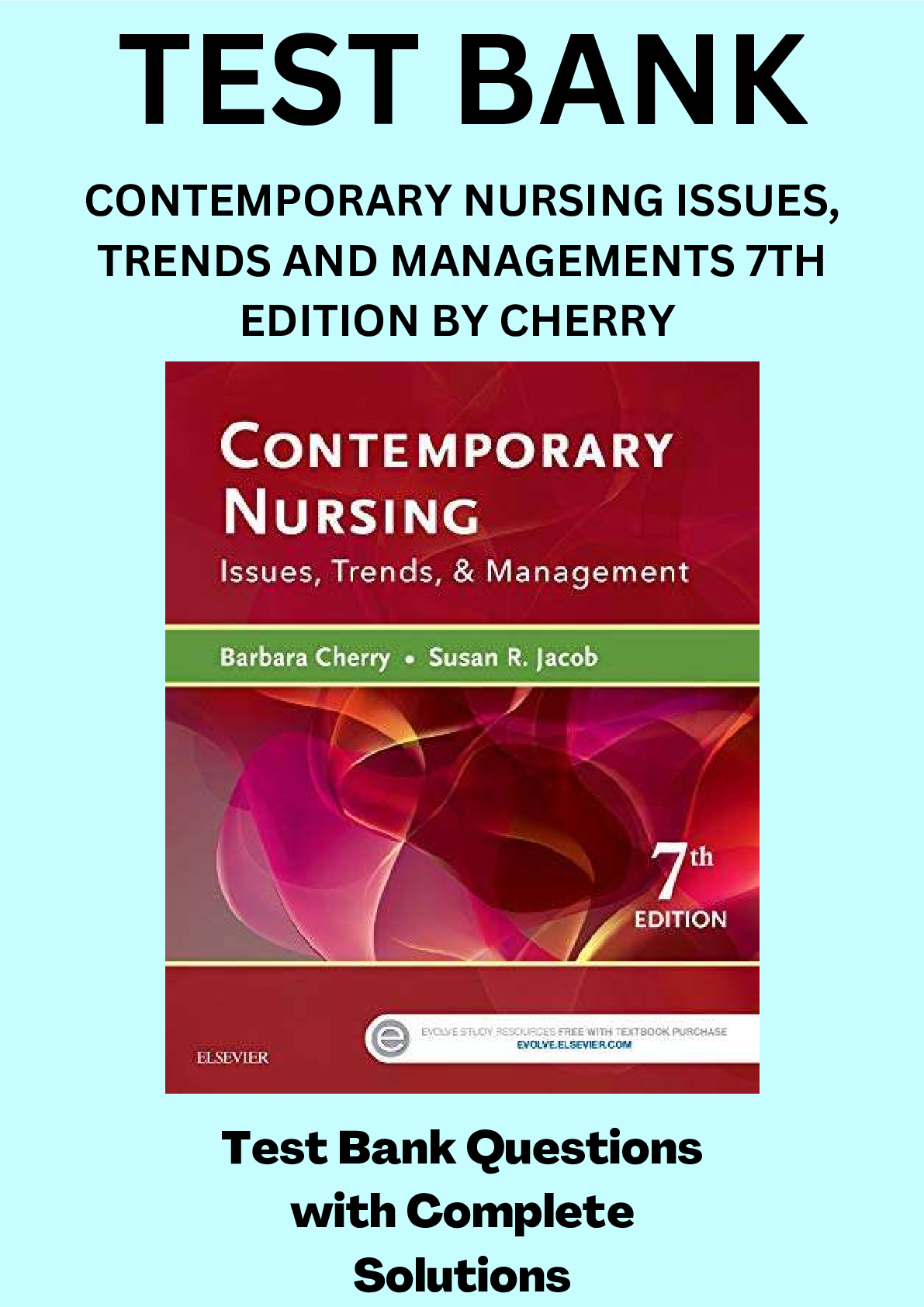
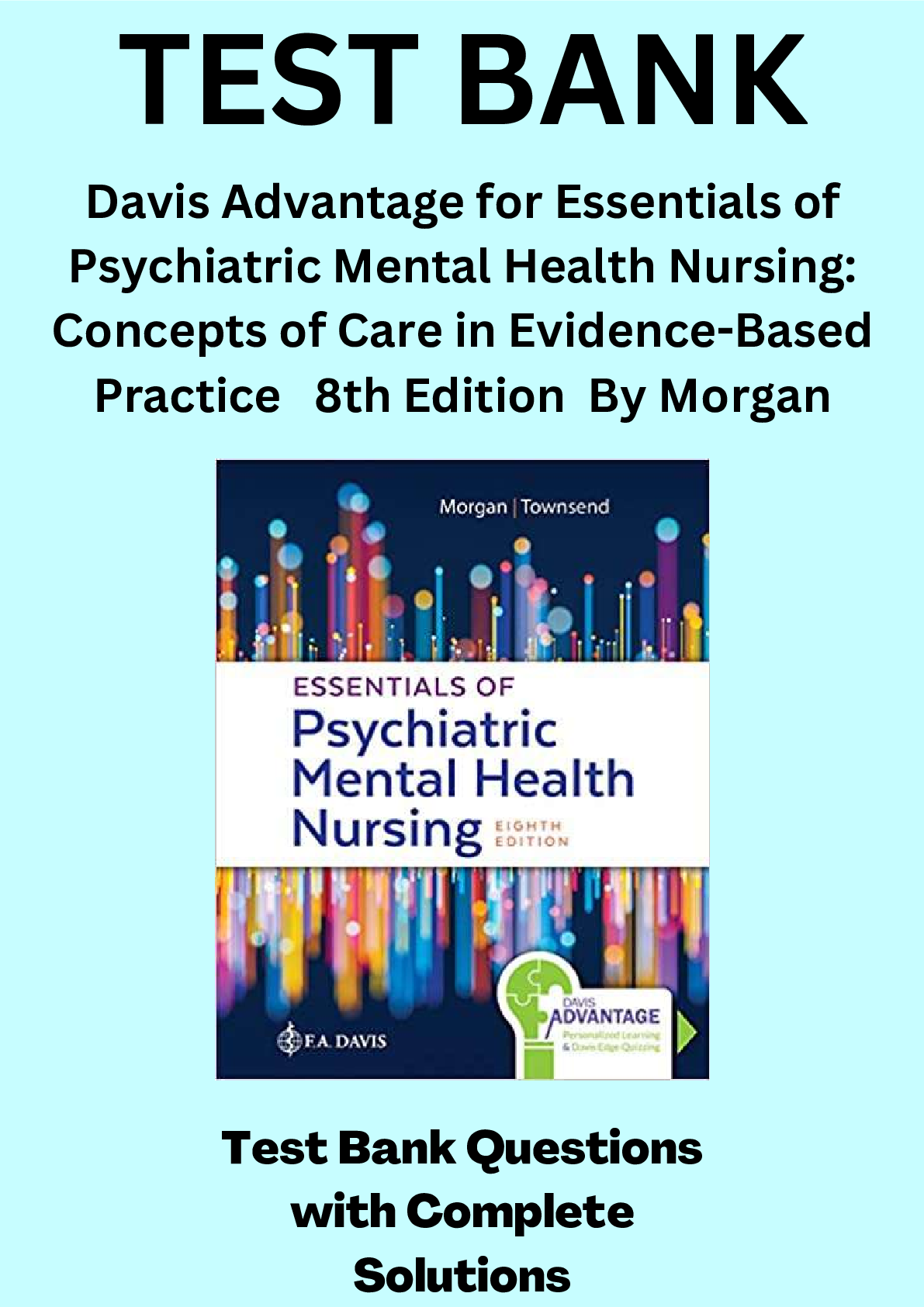
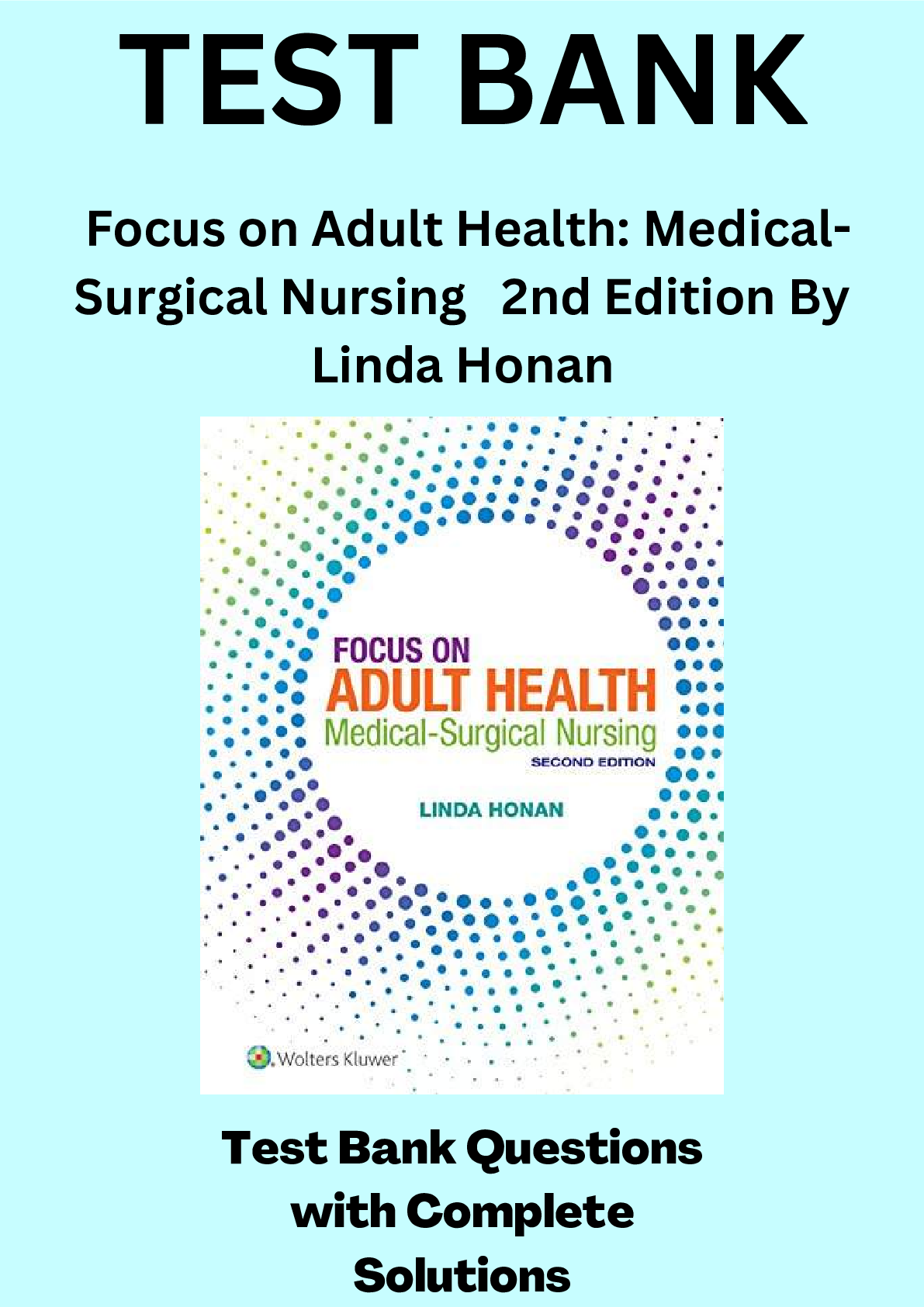



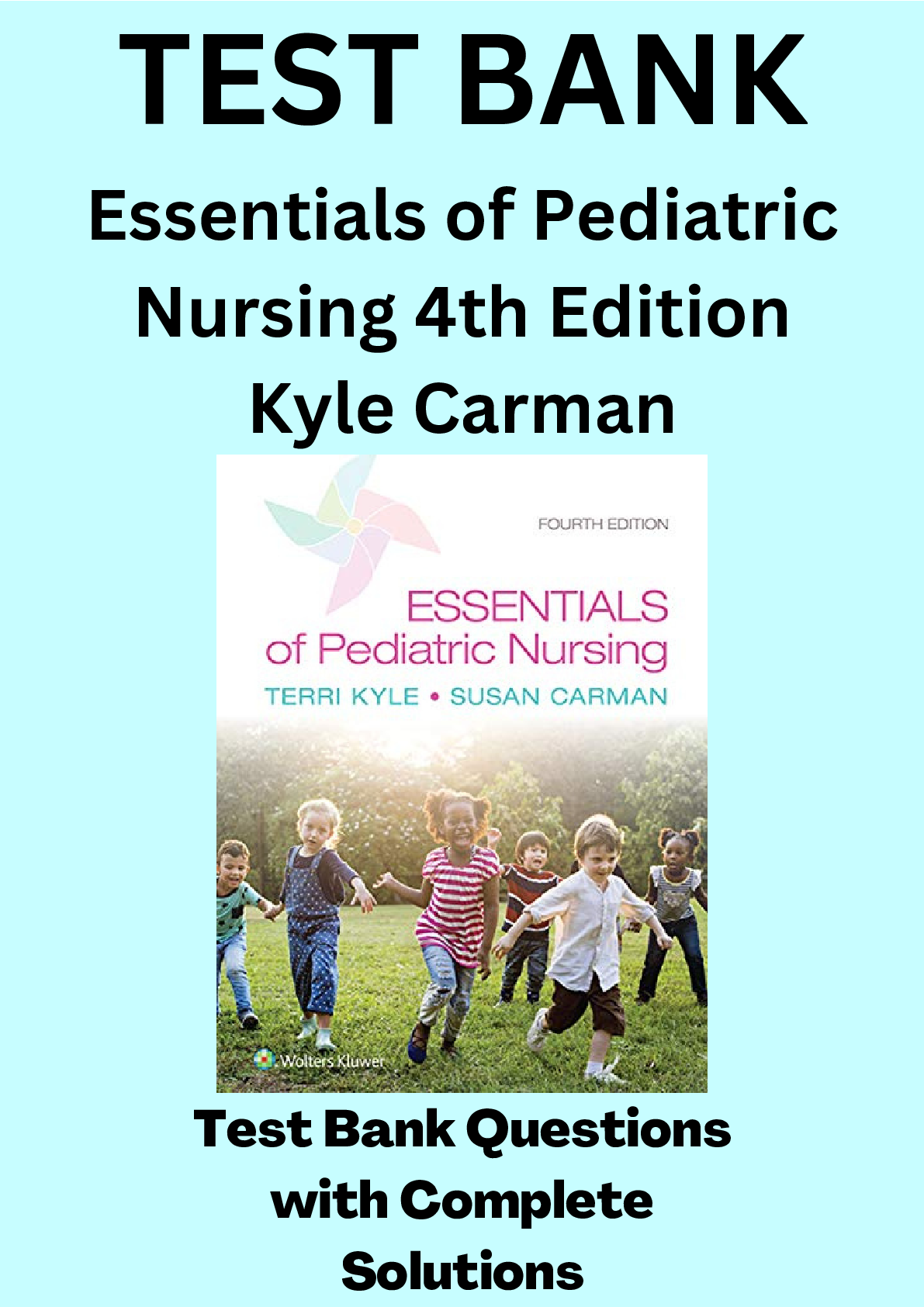
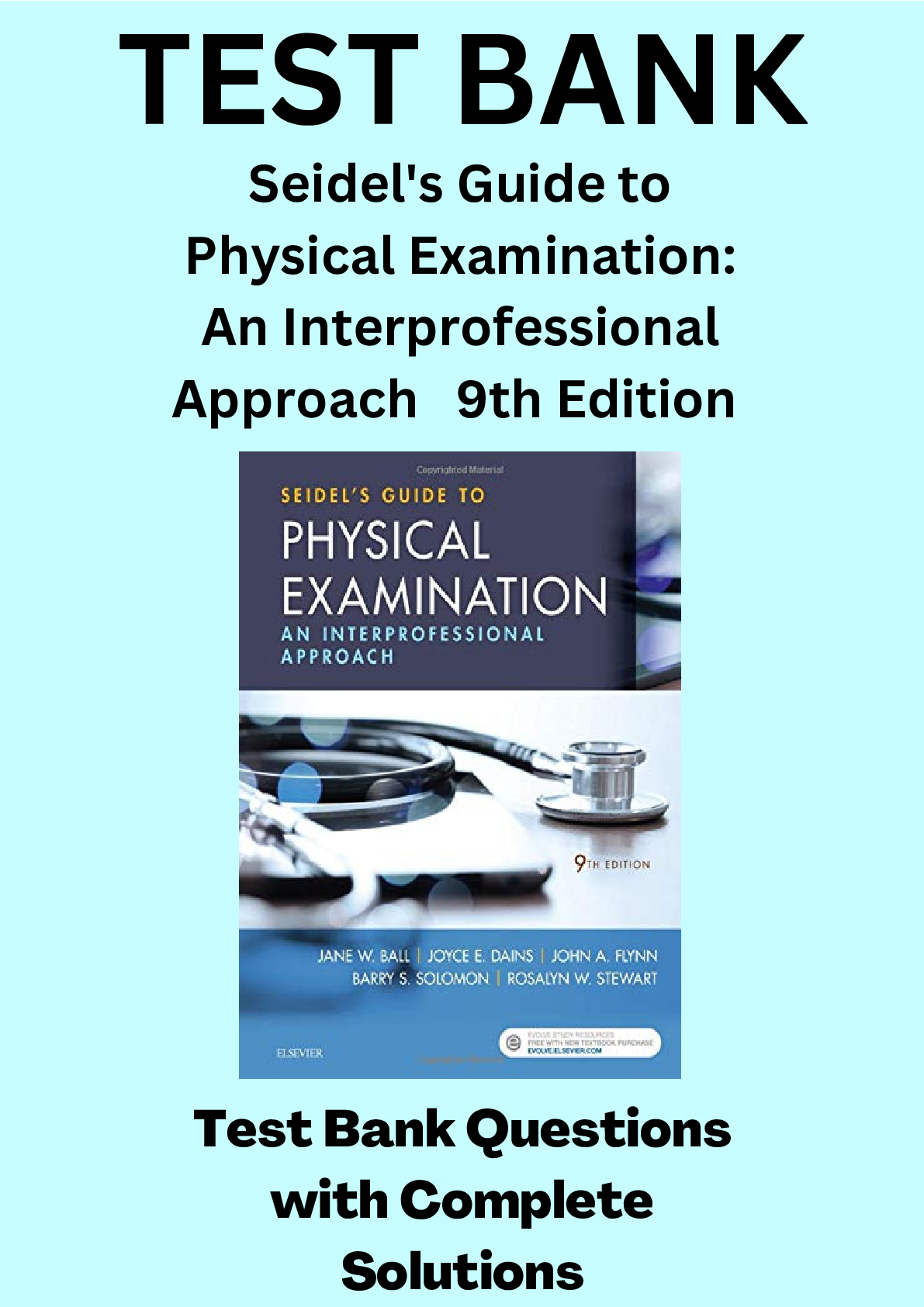
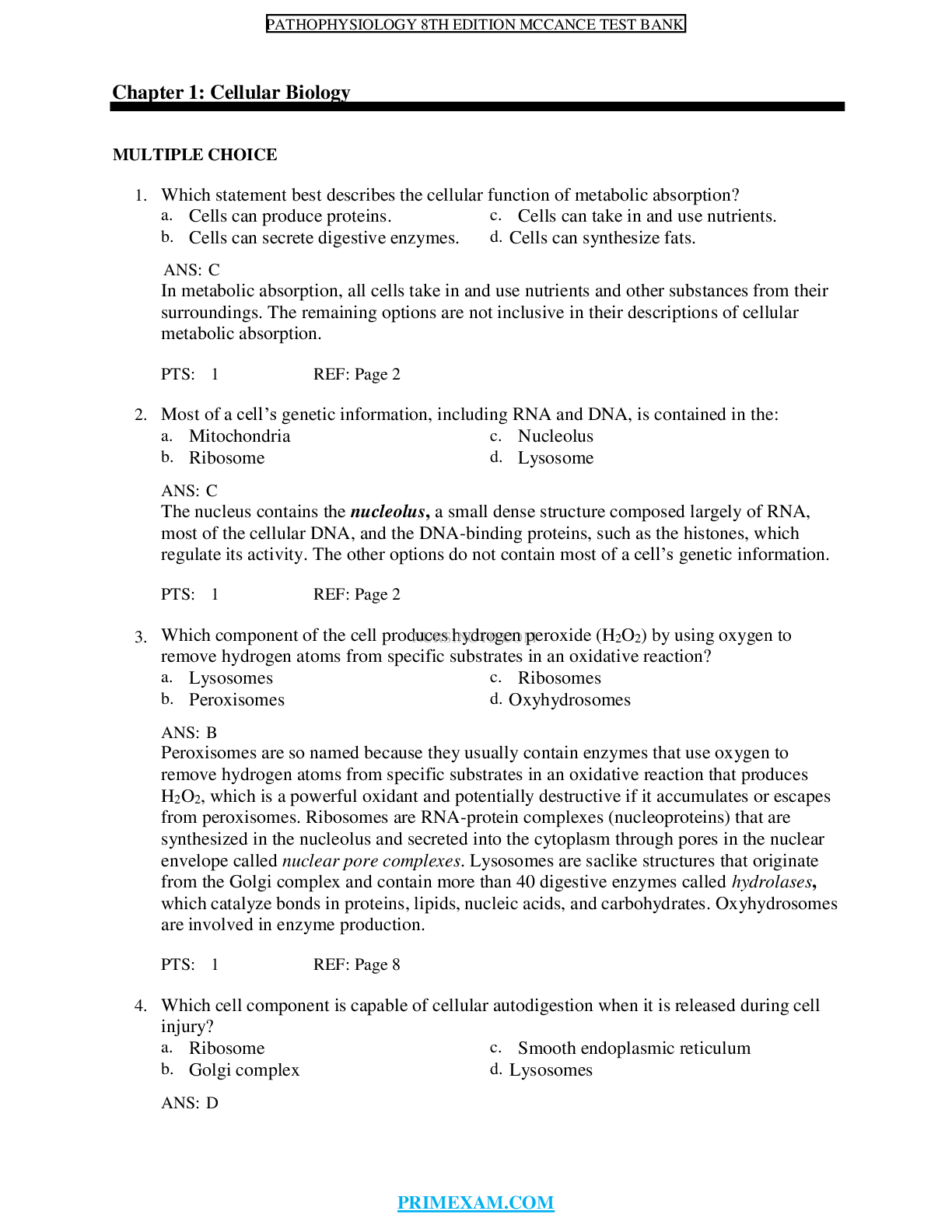
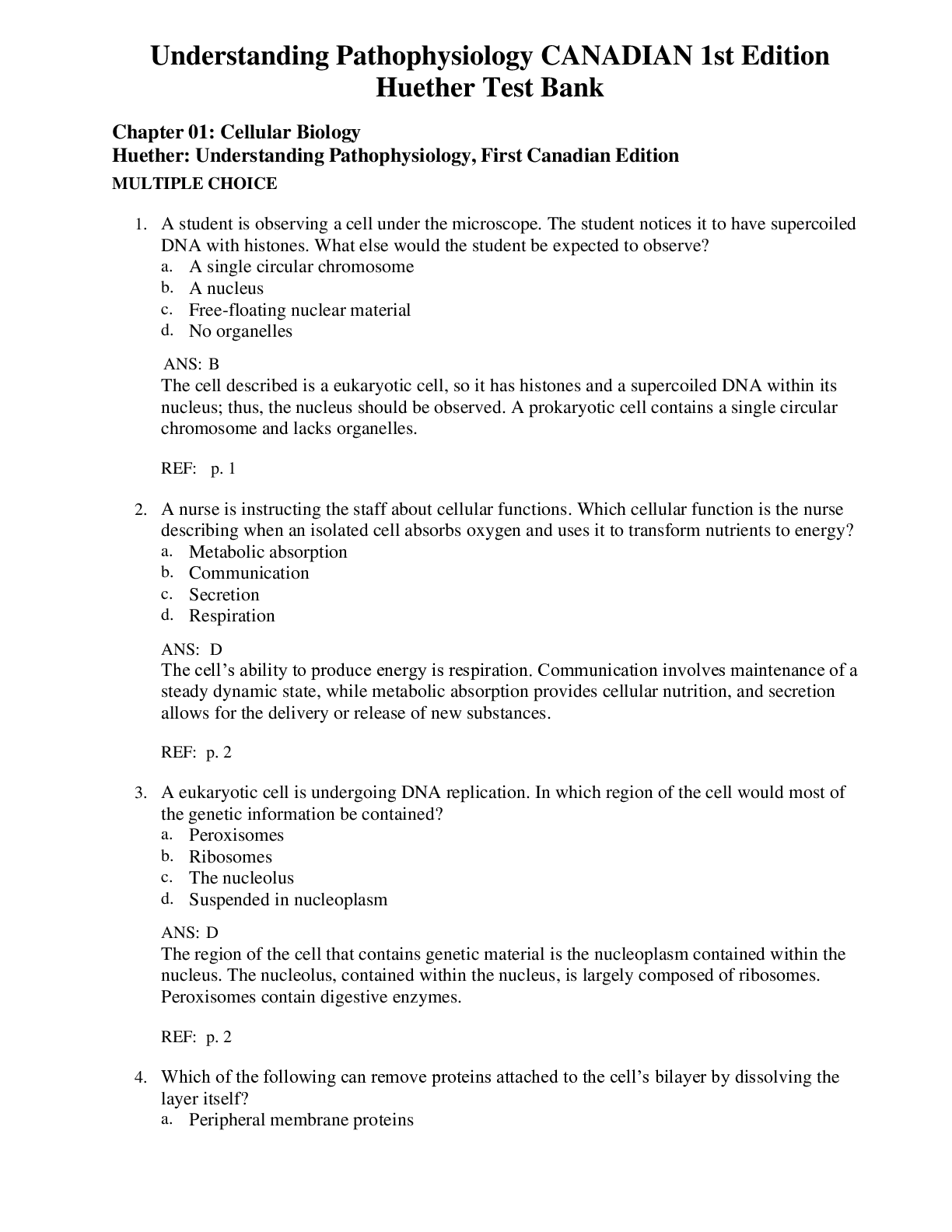


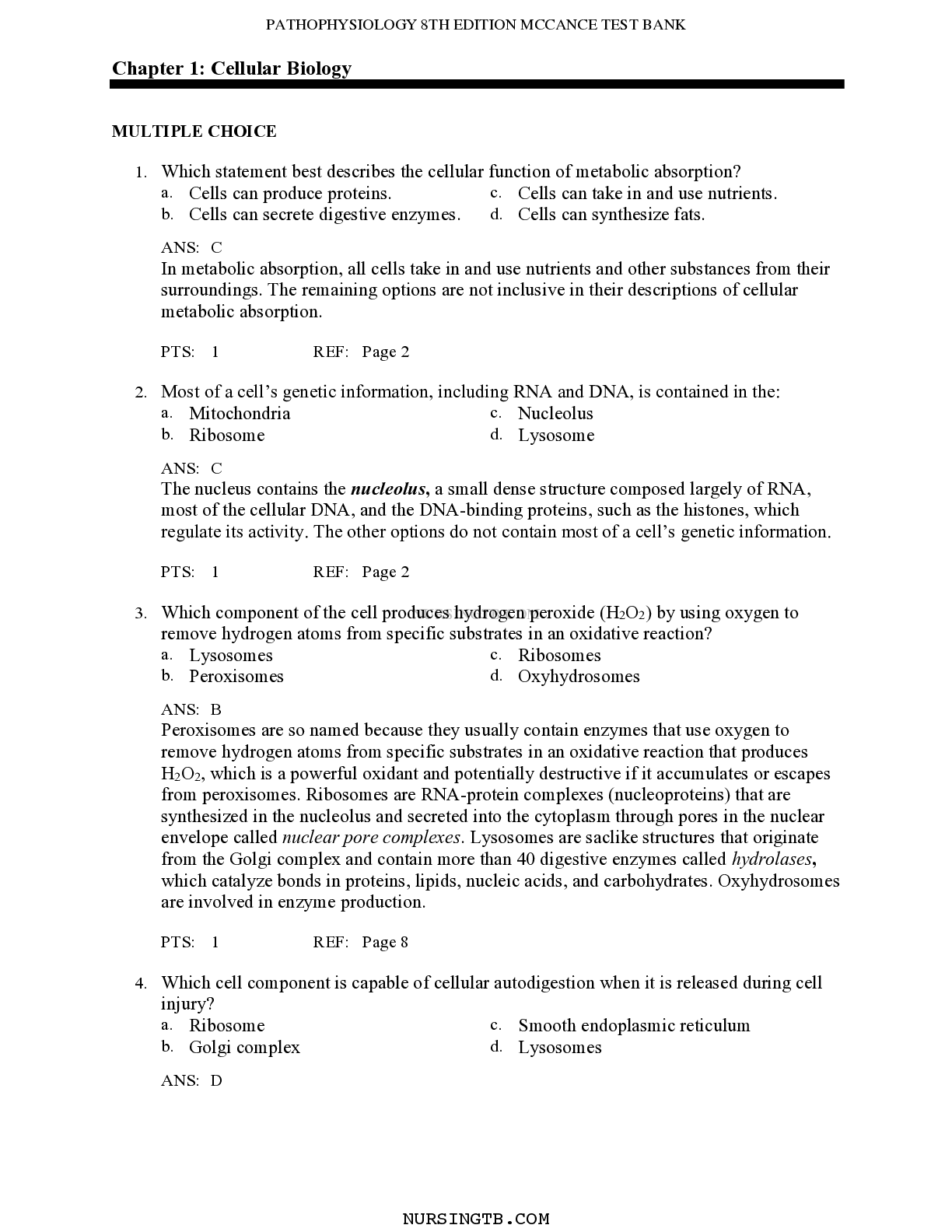

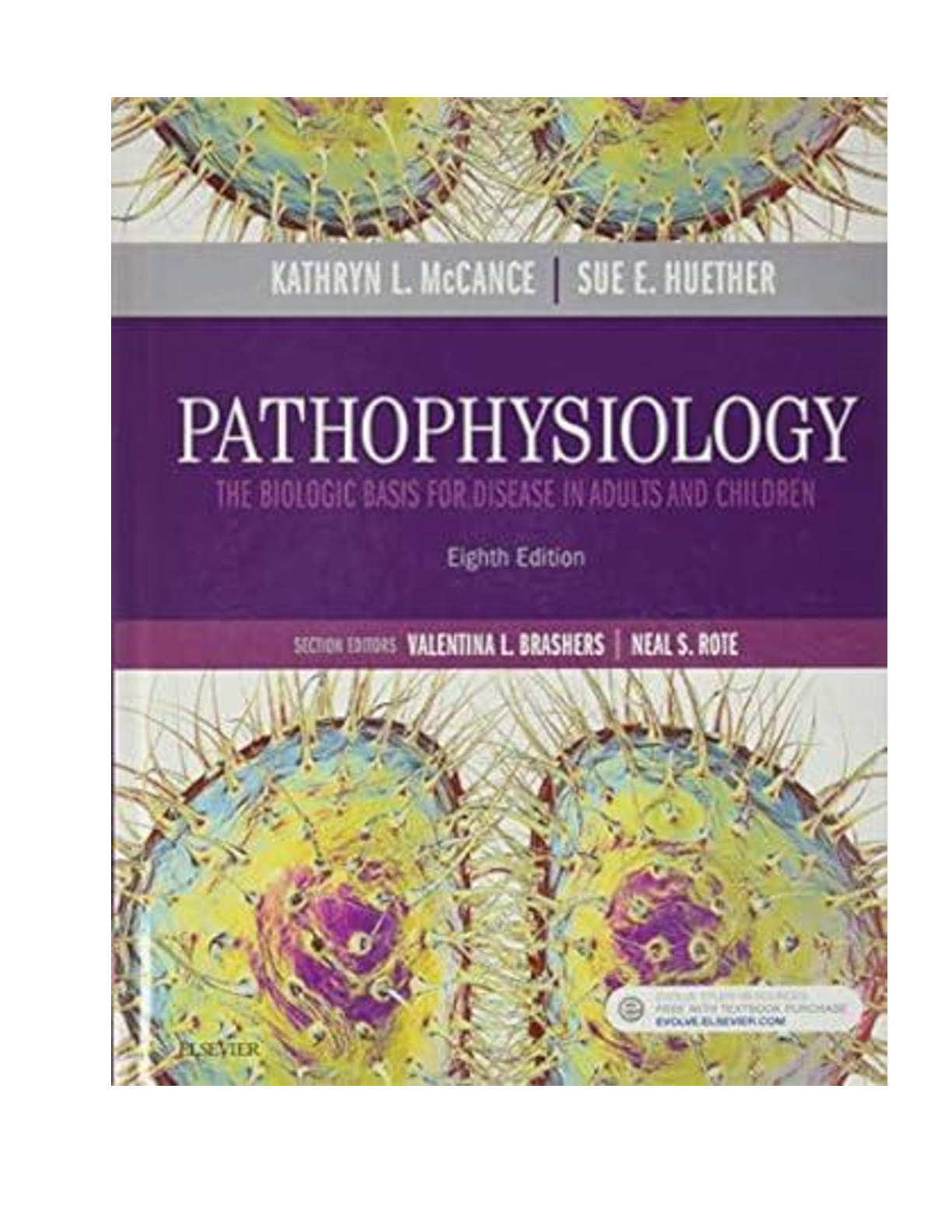
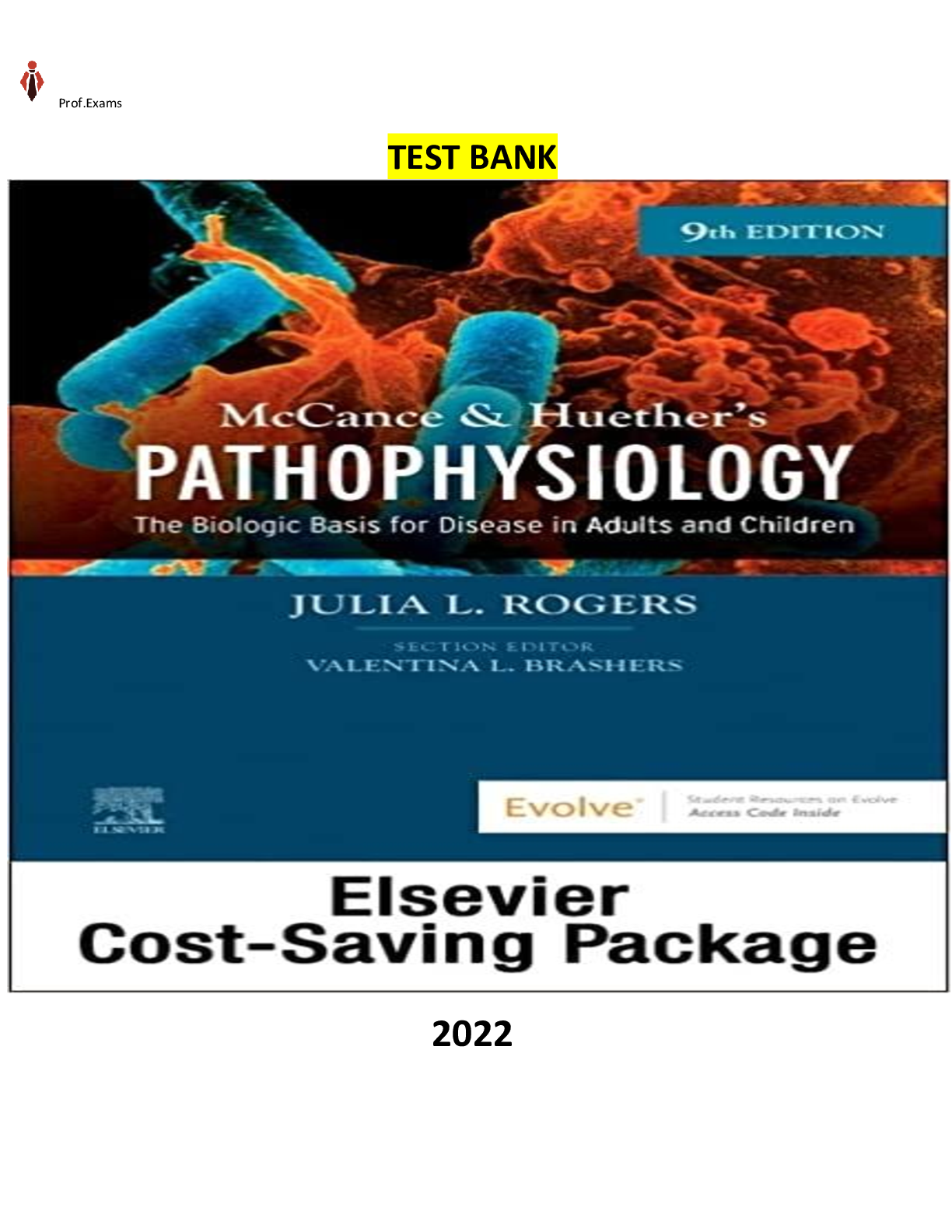
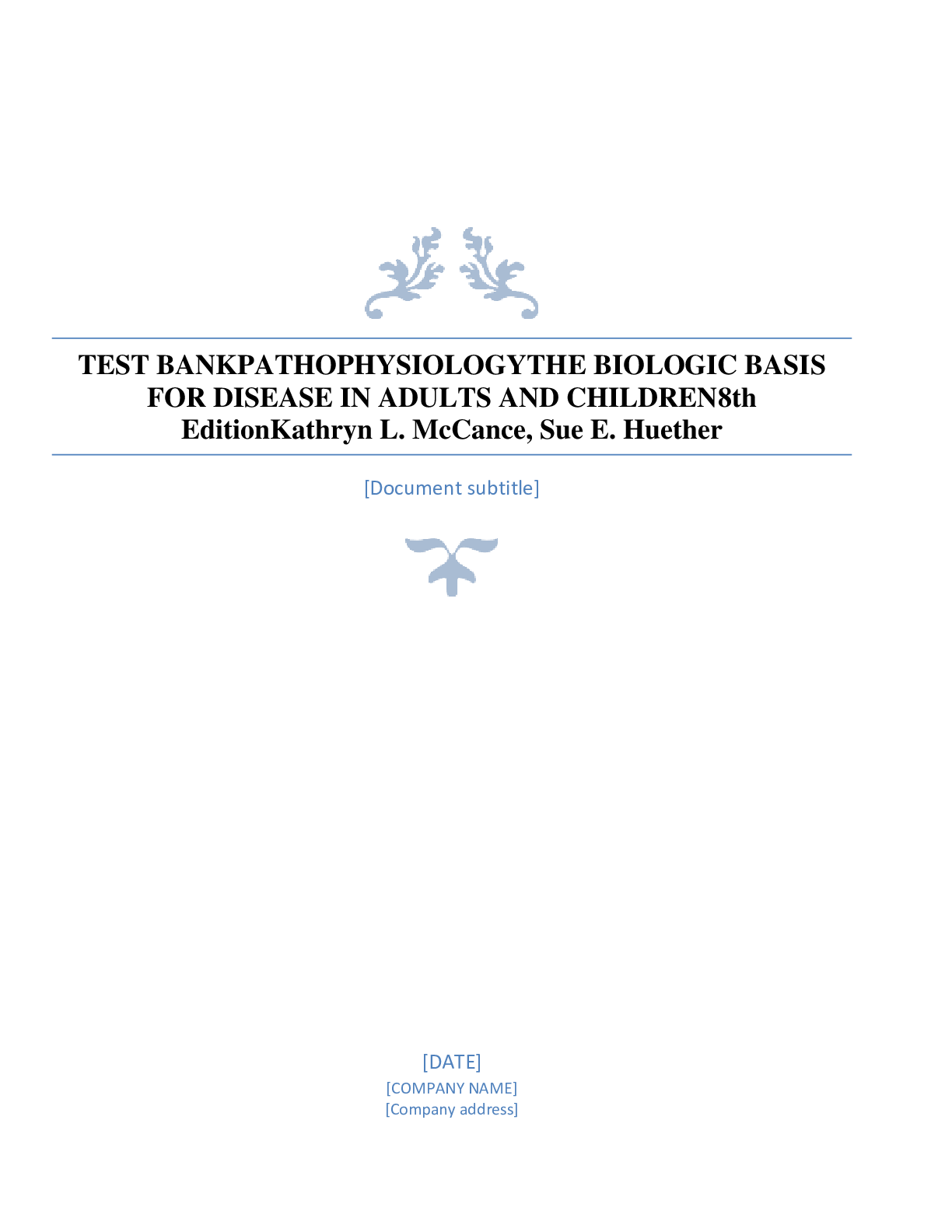

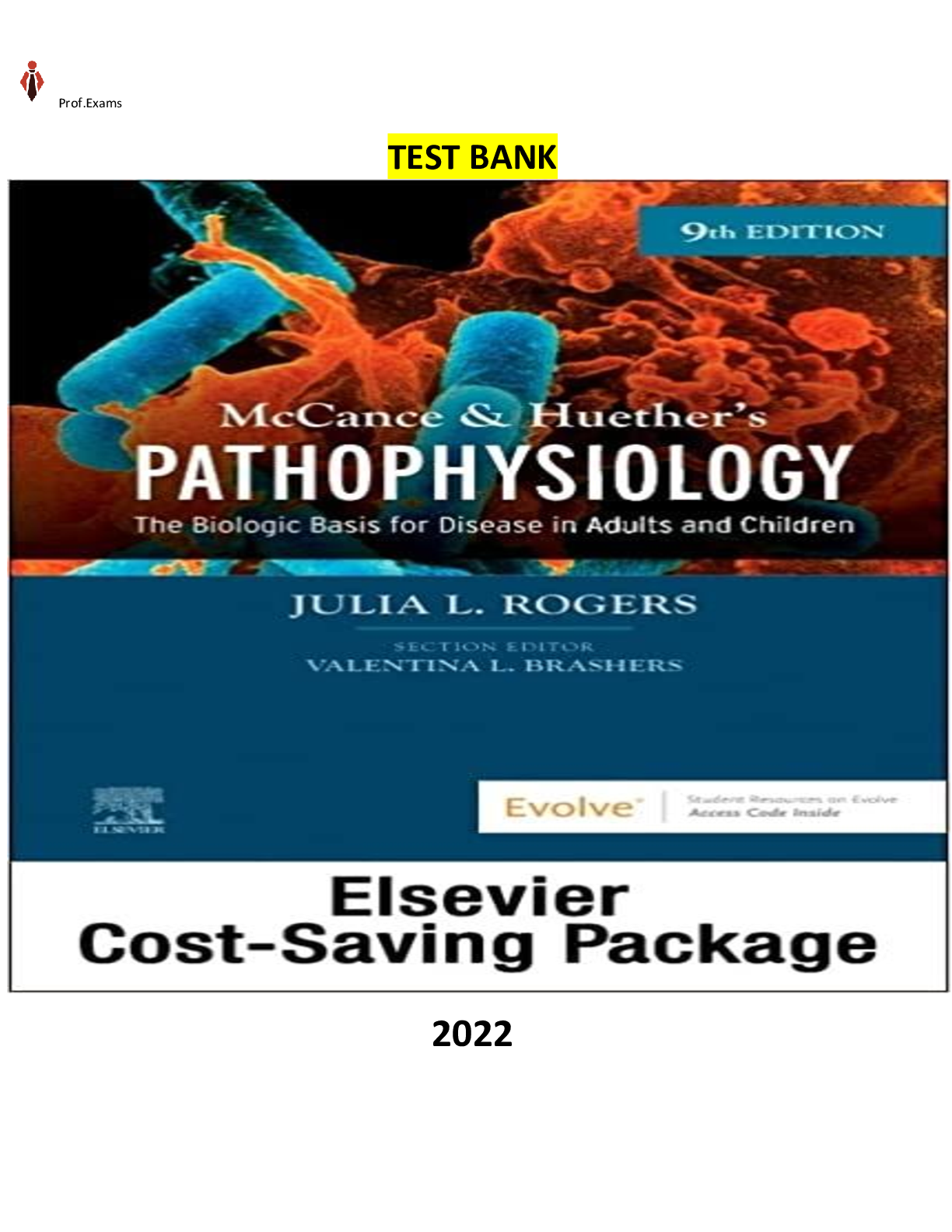
 - libgen.png)






